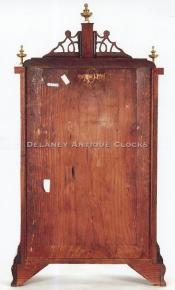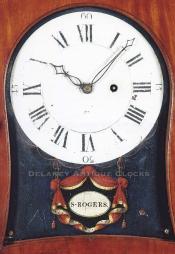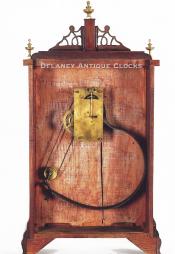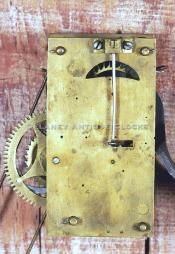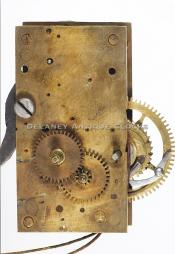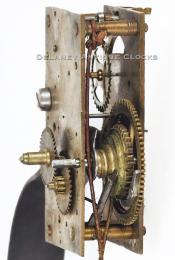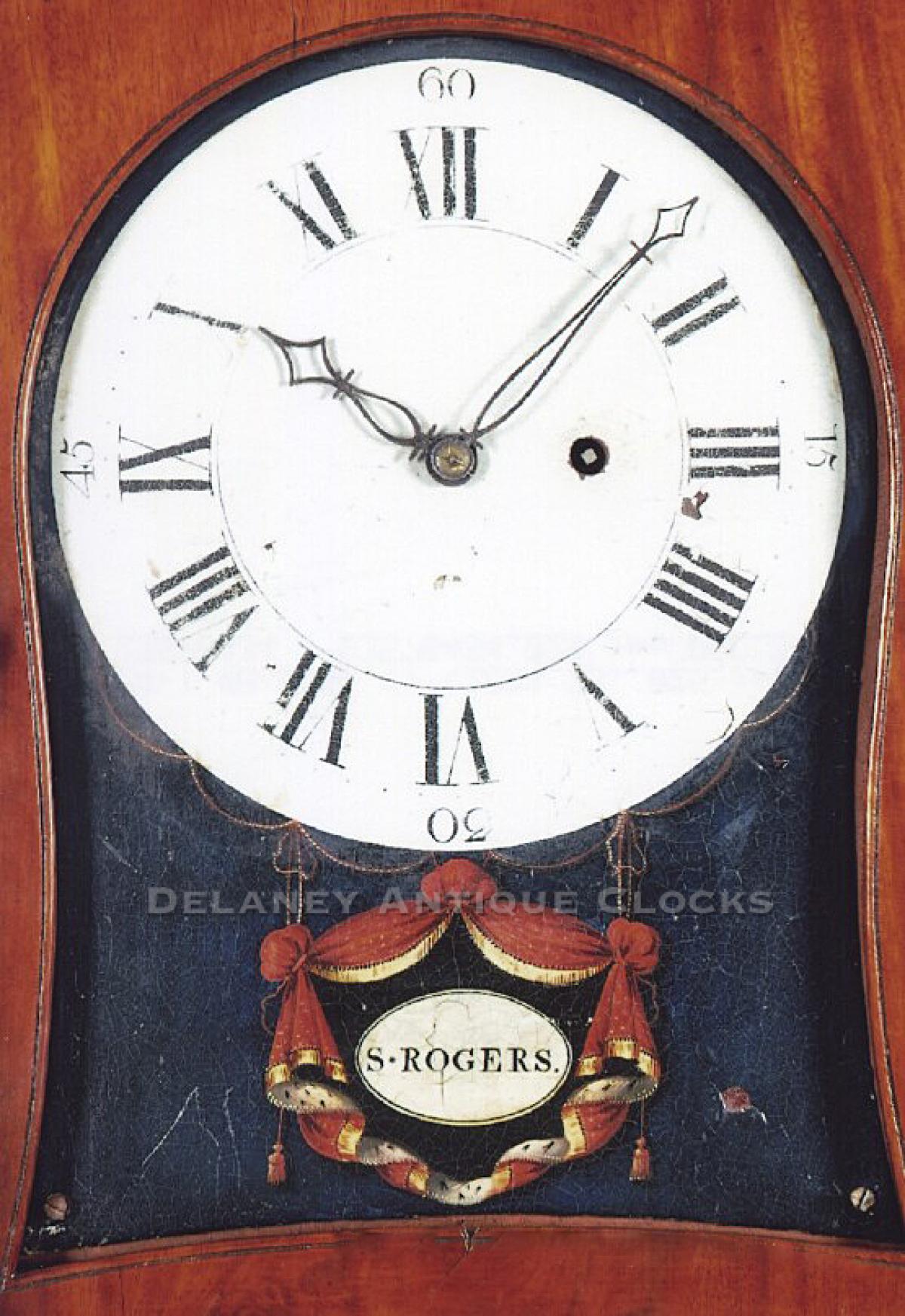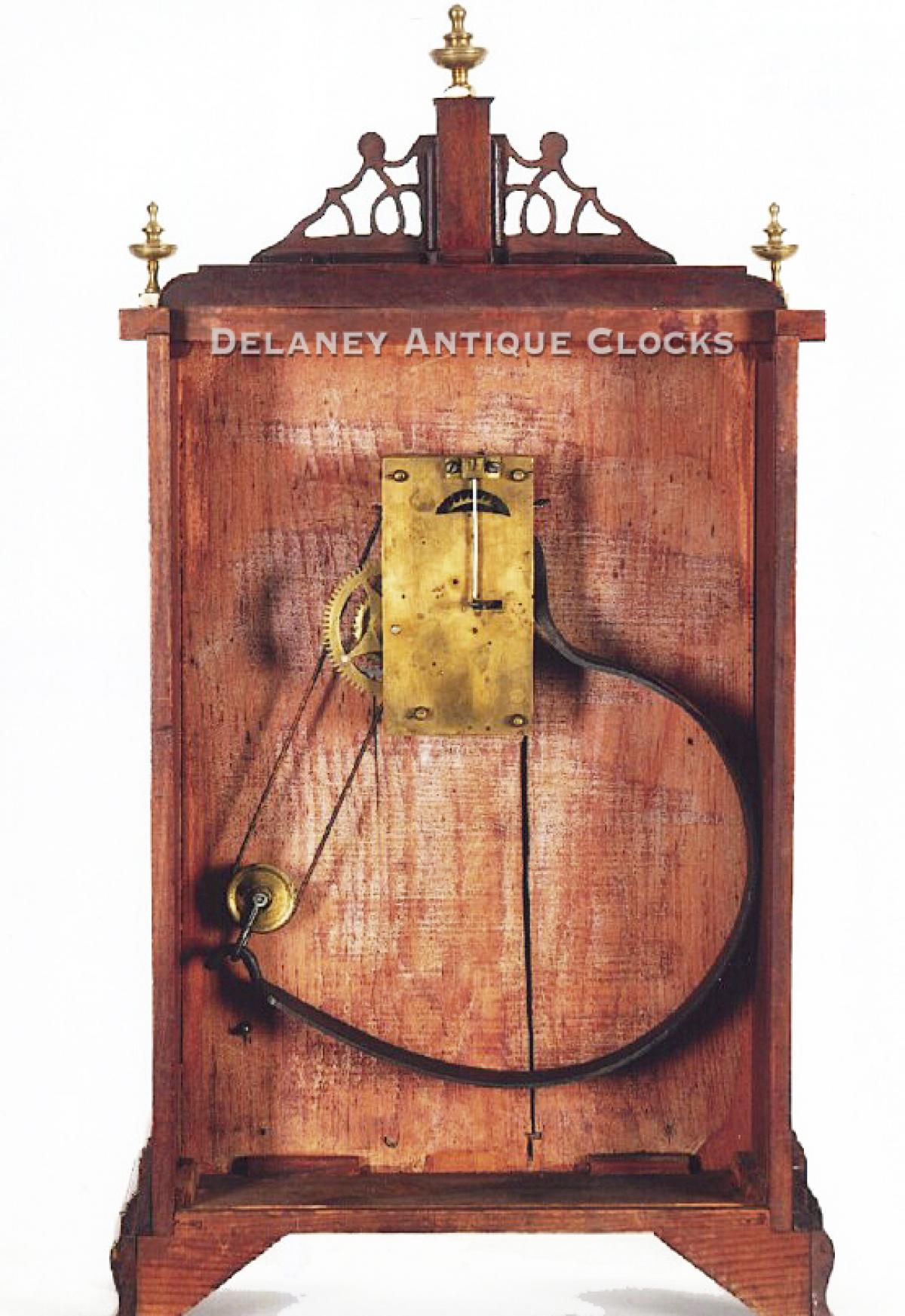Samuel Rogers of Plymouth, Massachusetts. A very unusual shelf clock form featuring a unique movement design with fusee, powered by an iron torsion spring. XXSL-7.
This Massachusetts Shelf Clock or Bracket Clock was made by Samuel Rogers of Plymouth and or Bridgewater, Massachusetts, circa 1790. It is one of only three examples that are currently known that share this case form and very unusual method of power. The decoratively inlaid case is constructed in mahogany and New England white pine. The clock is powered by an iron spring that engages a fusee winding barrel. Of the three clocks that are known, this example survives in the best condition and is the finest of construction and form.
This unusual case form is constructed in vivid ribbon mahogany and features barber pole inlay and cross-banding. The case is elevated up on four applied ogee bracket feet. These are applied to a double-step molding that transitions the feet to the case. The case section of the clock is fitted with a large door. The kidney-shaped opening is fitted with glass and conforms to the shape of the dial. The front corners of the case are trimmed with barber pole inlay. The cornice molding is lined inlaid with a cross-banded pattern centered in the molding. The top section is decorated with a nicely shaped plinth. Three brass finials are located here as ornamentation. The center finial sits on an elevated plinth. This plinth is also inlaid with a barber pole design. This helps to support the pierced fretwork pattern.
This fully painted decorated dial is iron and was most likely painted by John Minott of Boston. John Minott is listed as a dial painter and ornamental artist who worked in Boston. His dials appear on several clocks made by Simon and Aaron Willard, as well as Elnathan Taber and others in the 1790s. Interestingly, this dial is attached directly to the case. It is not mounted to the movement. We have seen this attachment method on several early Willard shelf clock examples. This example features a time ring formatted with large Roman hour numerals. The quarter hours are marked in Arabic form. Below the time ring is a decorative area where one will find the Maker’s name. This is signed in the oval in large block capital letters. It reads, “S. ROGERS.” A decorative and colorful curtain surrounds the oval. The colors play nicely against the deep blue field.
The movement may be unique to this Maker. It is constructed in brass and is of good quality. Four-turned pillars that are slightly shaped and decorated with ring turnings support the two brass plates. Hardened steel shafts support the polished steel pinions and brass gearing. The winding drum is grooved and tapered. The grooves accept the power cord in an orderly fashion. A winding stop is provided in the design. The tapering of the barrel helps to equalize the power provided by a torsion or single-leaf spring. This spring is constructed of iron. The trouble with any spring is that the force is not constant over the period of the power. The more you stress a spring, the more power it provides. As a result, the shape of the fusee barrel is loosely designed to help compensate for this variation. It is interesting to note that no other American clock from this period is known to be powered in this manner. The escapement is designed as a recoil format. An access window is provided in the backplate in the shape of a crescent moon. The pendulum is mounted slightly off-center. This example features a metal rod that supports a brass-faced bob with a rating nut below.
The mahogany and white pine case stands approximately 22.5 inches tall, 11.75 inches wide, and 4.5 inches deep.
Inventory number XXSL-7.
Samuel Rogers was born in 1766 and died in East Bridgewater, MA, on July 17, 1838. He was the older brother of Isaac Rogers Jr., who worked in Marshfield, Mass, as a clockmaker and the cousin of the Bridgewater clockmaker Ezekiel Reed. It is thought that Samuel was trained under the Hanover clockmaker John Bailey II, who was also a Quaker. Soon after he finished his apprenticeship with Bailey in 1788, Samuel moved to Bridgewater, MA. Here, he demonstrated that he was an ingenious clockmaker and inventor. Here, he became involved with nail making and applied for and received three patents for designs of nail-cutting machines or metal working machines. In 1804, he moved his family to Plymouth and worked as a clockmaker. Here, he came up with a very unusual method of powering a shelf clock by designing what may be the first use of a “wagon spring” or torsion spring movement. Three such shelf clocks are known. In 1808, he returned to Bridgewater. Tall case clocks, dwarf clocks, and shelf clocks are known.


